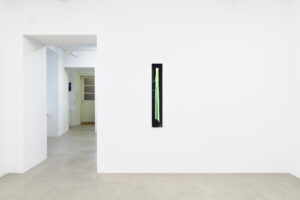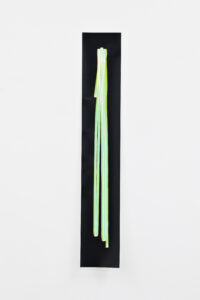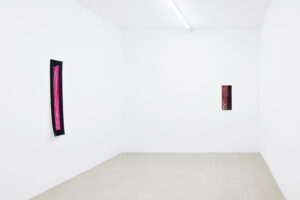
The Meters of Colors series of photographic objects constitutes the latest stage in Philipp Fleischmann’s artistic research into the relationship between space and time, still images and moving images.
This series is composed of photographic objects having unusual shapes, some very long and/or equally narrow, and are, as their title makes explicit quite literally, meters of colors imprinted on photo- graphic paper. More precisely, they are filmstrips exposed to a source of colored light from which Fleischmann will later remove the perforations on the side. The dimensions of the Meters of Colors objects depend strictly on the length of the film, firstly shaped by the artist, then directly placed onto the photographic paper. It is precisely around the inseparable physical correspondence of the photograph with its referent (in this case the filmstrip) that Fleischmann’s research proceeds. The titles of the photographs—to be exact, photograms—for example, Five meters of Green or Nine meters of Vinaccia, in fact allude to their referent, namely, exactly five meters of green-colored film and nine meters of burgundy-colored film, revealing Fleischmann’s interest in a specific aspect of the photographic medium, as Krauss puts it, its “indexical” nature.[1]
To understand the conceptual scope of Meters of Colors, however, it is necessary to take a step back and retrace some of the key stages of Fleischmann’s research. By viewing the exhibition space as a field of possibilities and
using the language of film in particular, the artist creates environments for complex media experiences. Skeptical of the cinema of representation, which only exploits a small part of the medium’s expressive potential, Fleischmann uses analog film by means of hand- made camera devices to “let the medium express itself”.[2] This results in his Film Sculptures, works in which the medium of film is simultaneously articulated and experienced in various forms and states: from the device to the film to the projected images. The sensitive surface of the filmstrip is not used as a support, but rather exalted in its sheer materiality and its ability to orchestrate light, echoing the filmic experiments of the New Objectivity, first and foremost Laszlo Moholy Nagy, whose celebrated Painting, Photography, Film has served Fleischmann as a key reference.[3]
In addition, the Film Sculptures challenge the rules imposed by the cinema of storytelling and propose alternative ways to the frontal and traditional film experience, encouraging reflection on the multiple possibilities of abstract film as a vehicle for the expression of queer sensibilities (Queer Abstraction), a critical thinking that takes its cue from the writ-ings of David J. Getsy.[4] Returning to Meters of Colors, it is thus evident how the ex-perience of Film Sculptures progressively led the artist to question the relationships be- tween still and moving images and the material aspects of film and photography.
As for the removal of the perforations on the side of the
filmstrip, the so-called sprocket holes, this simple gesture is revealing of an awareness of a practice that can be interpreted from a media history perspective. According to the artist, the essence of the aesthetics of representational cinema could be traced back to the material fact of the perforation holes; to leave them visible in static photography would en- tail the risk of a fetishistic and erroneous interpretation of the artist’s practice which, far from mourning the death of analog cinema, rather reflects a technological present in which the past is an integral part, and which is the result of complex cultural stratifications.[5]
Freed from the constraint of the sprocket holes, Fleischmann indulges in the film as a pure vehicle for color, using it as a body moving freely in space, leaving its mark on the photo- graphic paper, which then inhabits the exhibition space with a certain freedom. The Meters of Colors, hung but never framed, are seductive objects, and although they are the result of a photomechanical process and the artist’s act of arranging, they invite the viewer to indulge and dive in their generous materiality; their imperceptible oscillatory mo-tions recall the interpretation of Marcel Duchamp’s Large Glass (1915–1923) proposed by Rosalind Krauss. According to the critic’s reading, the “draught’s pistons,”—three irregular square holes within a cloud located at the top of the Large Glass—, would be the literal transcription of three pieces of fabric moved by a draught. Just as, in the case of the detail of the three pistons in one of the most
cryptic and erotic works in the history of twentieth-century art, we cannot help but wonder about the physical relation- ship with its referent, similarly Fleischmann’s Meters of Colors, with their presence and ubiquitous nature, restore the seductive allure of matter and the mystery of light writing.
Chiara Agradi
Chiara Agradi is a curator and art historian based in Paris. Her main area of research is the media of photography. She has recently curated projects for Fondation Cartier, Triennale di Milano, Palazzo Barberini, and artgenève.
[1] Rosalind Krauss, Le photo- graphique, pour une théorie des écarts, Macula, 2022, pp 91–110
[2] Conversation between Chiara Agradi and Philipp Fleischmann, March 2024
[3] Somaini Antonio (dir.), Laszlo Moholy Nagy, Pittura Fotografia Film, Einaudi, 2010
[4] See for example: David J. Getsy, “Ten queer theses on abstraction”, in Jared Ledesma, et., Queer Abstrac- tion, exh. cat. ( Des Moines : Des Moines Art Center, 2019), 65–75.
[5] The attachment to obsolete media practices is pointedly argued by Jussi Parikka, who justifies these phenomena of “retrocultures” by
the affection of a large segment
of the population to media whose use has penetrated households
for decades; cinema, like instant photography, falls perfectly into this media category. Cf. Jussi Parikka, What is media archeology, John Wiley & Sons, 2013. In the Italian version published by Carocci Editore pp. 29–48.















